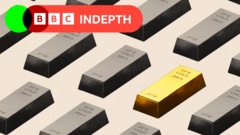Gold's price has experienced a remarkable 40% increase over the past year, sparking significant demand amid concerns over inflation and geopolitical tensions. Industry experts indicate that this surge is fueled by a mix of factors, including central bank buying and a flight from instability in other markets. Historically considered a safe investment, the question now remains: how stable is gold really, and could we witness a market correction?
The excitement around gold is palpable in London’s Hatton Garden, where dealers report a dramatic increase in demand. Emma Siebenborn, the strategies director of Hatton Garden Metals, showcased a collection of gold scrap and finer pieces, noting the enthusiasm—and anxiety—of current investors. With gold’s price surpassing $3,500 per troy ounce, reaching record highs not seen since 1980, many see it as a reliable hedge against economic instability.
Economists have attributed these changes to precarious US trade policies, heightened geopolitical risk, and the historical role of gold as a store of value. Louise Street from the World Gold Council explains that rising inflation and increasing uncertainty have created a "perfect storm" for gold investments. However, while gold has a reputation for stability, it is not immune to volatility, leading to fears of a market bubble.
Historically, significant increases in gold prices have often been followed by sharp declines. For instance, the price surged in early 1980, only to plummet dramatically in subsequent months. Similarly, peaks in 2011 were accompanied by notable downturns. Analysts now wonder if today's market could experience a similar reversal.
A notable driving force behind the recent demand stems from central banks that have been net buyers of gold, accelerating purchases considerably in recent years. Countries like Russia and Turkey view gold as a safeguard against currency volatility, particularly in light of recent geopolitical provocations. This heightened demand from state institutions could support gold prices, yet uncertainty remains about when that momentum might change.
Some experts predict that if conditions stabilize—such as peace negotiations in Ukraine or de-escalation of trade tensions—investors might shift back into riskier assets, potentially leading to a price dip. Conversely, Daan Struyven from Goldman Sachs suggests gold prices may escalate further due to the small market size in relation to stock indices.
There is also concern that new investors, drawn in by the current upswing, may face disappointment if a correction occurs. Susannah Streeter of Hargreaves Lansdown warns against overexposure to gold, emphasizing the need for diversified investment approaches.
In the end, while gold may still represent a sound investment strategy, potential investors are advised to weigh the risks carefully against their long-term financial goals.
The excitement around gold is palpable in London’s Hatton Garden, where dealers report a dramatic increase in demand. Emma Siebenborn, the strategies director of Hatton Garden Metals, showcased a collection of gold scrap and finer pieces, noting the enthusiasm—and anxiety—of current investors. With gold’s price surpassing $3,500 per troy ounce, reaching record highs not seen since 1980, many see it as a reliable hedge against economic instability.
Economists have attributed these changes to precarious US trade policies, heightened geopolitical risk, and the historical role of gold as a store of value. Louise Street from the World Gold Council explains that rising inflation and increasing uncertainty have created a "perfect storm" for gold investments. However, while gold has a reputation for stability, it is not immune to volatility, leading to fears of a market bubble.
Historically, significant increases in gold prices have often been followed by sharp declines. For instance, the price surged in early 1980, only to plummet dramatically in subsequent months. Similarly, peaks in 2011 were accompanied by notable downturns. Analysts now wonder if today's market could experience a similar reversal.
A notable driving force behind the recent demand stems from central banks that have been net buyers of gold, accelerating purchases considerably in recent years. Countries like Russia and Turkey view gold as a safeguard against currency volatility, particularly in light of recent geopolitical provocations. This heightened demand from state institutions could support gold prices, yet uncertainty remains about when that momentum might change.
Some experts predict that if conditions stabilize—such as peace negotiations in Ukraine or de-escalation of trade tensions—investors might shift back into riskier assets, potentially leading to a price dip. Conversely, Daan Struyven from Goldman Sachs suggests gold prices may escalate further due to the small market size in relation to stock indices.
There is also concern that new investors, drawn in by the current upswing, may face disappointment if a correction occurs. Susannah Streeter of Hargreaves Lansdown warns against overexposure to gold, emphasizing the need for diversified investment approaches.
In the end, while gold may still represent a sound investment strategy, potential investors are advised to weigh the risks carefully against their long-term financial goals.




















